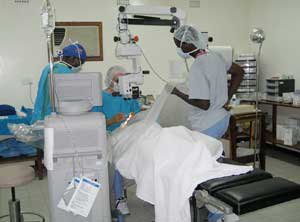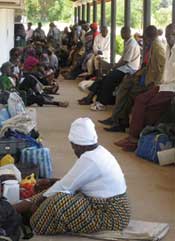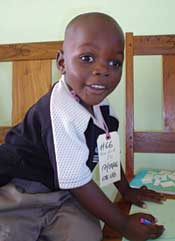Group offers services to Zambians with little access to eye care
Nonprofit organization seeks to address need in Africa for congenital cataract surgery in children and glaucoma and cataract treatment in adults.

A medical missionary stint 37 years ago in Sierra Leone gave James W. Tysinger, MD, not only a medical specialty but also a connection to the region that would eventually lead to his helping establish an ophthalmic clinic in Zambia.
Dr. Tysinger was unsure of his specialty when he traveled as a medical missionary in 1970 to Sierra Leone, where he lived for 3 years. One day, after assisting two ophthalmologists in surgery, he said he decided to study ophthalmology and bring ophthalmic care to those in need in Africa. Throughout the years after his medical training, he returned to Sierra Leone and performed ophthalmic surgery until civil war rendered it too dangerous to visit in 1994.
 John A. Hovanesian |
That same year, Dr. Tysinger, along with Thomas Brumley, MD, and Robert Grosserode, MD, founded International Vision Volunteers, a nonprofit ophthalmic outreach organization.
In 2000, the group built a 3,200-square-foot clinic in Zambia, where volunteer physicians have now performed hundreds of surgeries. Dr. Tysinger said the country’s stable political climate has allowed the organization to settle there, laying the groundwork for it to establish the ocular clinic, open a guest house, recently start a dental clinic and provide a public library for the community.
“Everyone who goes falls in love with the people there, and I would say that probably 85% to 95% of people who go, return,” Dr. Tysinger said in a telephone interview with Ocular Surgery News. “They get great satisfaction out of helping people. They see the need and keep going back.”
|
Images: Tysinger JW |
How the clinic works
Several times a year, International Vision Volunteers sends a team of two to three surgeons and others to treat all patients at the clinic in Zimba, Zambia, for 2-week stints, Dr. Tysinger said. During that time, the team examines 400 to 700 patients. About 100 surgeries, 15 to 25 minor surgeries and 15 YAG lasers are performed. In addition, about 50 to 75 glasses are dispensed.
Patients begin lining up outside the clinic before it opens, he said. They arrive by foot, vehicle and other means, sometimes from miles away, and some have to camp outside the eye clinic until their ocular concerns have been examined and treated.
Dr. Tysinger said the need for eye surgery, especially cataract surgery for bilateral cataracts, is overwhelming in the landlocked nation of Zambia, which geographically is roughly the size of France. Allergic conjunctivitis and eye trauma from eye injuries are also problems in the country.
“I only know of one Zambian ophthalmologist,” he said. “It’s a country of about 11 million people, and eye care is mainly provided by mission hospitals.”
The country also has high levels of poverty, with 68% of the urban population and 78% of the rural population below the recognized national poverty line, according to United Nations statistics. Dr. Tysinger said cost becomes a problem for Zambian patients with diseases such as glaucoma, which requires regularly administered medication to control its progression.
He said physicians at the clinic can chart patients’ progression and monitor their glaucoma, but more education is needed to inform patients about the need to seek out medical attention and comply with their treatment regimens.
In too many cases, by the time a patient is seen, it is already too late to help, Dr. Tysinger said. He recalled one man who worked at the nearby Zimba Weslayan Mission Hospital who brought his father to the clinic. His father’s glaucoma had already advanced to the point of causing blindness. This could have been prevented had the man visited the clinic sooner, he added.
|
|
|
Who the clinic serves
Dr. Tysinger said the clinic shows the need for increased public awareness about glaucoma and congenital cataracts in Zambia. Many pediatric cataract patients do not receive medical care in time to prevent the onset of amblyopia.
According to the International Vision Volunteers’ Web site, congential cataracts in Zambian children are associated with problems during pregnancy, including a high rate of measles and other diseases, poor nutrition and other unexplained causes.
Other children develop cataracts in the first few months of life because of malnutrition, measles, disease and trauma. Some of those children never receive care and die as a result of neglect from their families, according to the organization.
Organization officials have calculated that a child’s cataract surgery at the clinic can be sponsored for $75, along with subsidies from volunteers’ time and other supplies and equipment donated. Dr. Tysinger said such cataract surgery is standard to perform but of overwhelming importance to the children and adults who undergo the procedure. Once, in Sierra Leone, he operated on an approximately 20-year-old woman who had bilateral cataracts.
She had never seen her baby, Dr. Tysinger said. After her vision was restored through surgery, she saw her child for the first time.
“You take the first cataract out, and they just ‘ooh’ and ‘ahh.’ … I’ve had people cry,” Dr. Tysinger said. “It’s a thrilling thing.”
|
For more information:
- James W. Tysinger, MD, can be reached at 440 Berrendos Ave., Red Bluff, CA 96080; e-mail: budles@sbcglobal.net; Web site: www.internationalvisionvol.org.
- Erin L. Boyle is an OSN Staff Writer who covers all aspects of ophthalmology.



